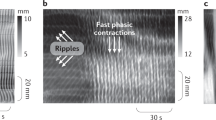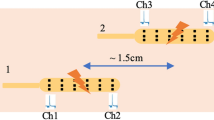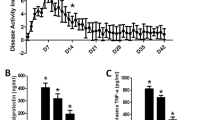Abstract
Colorectal distension (CRD) is a widely used and reliable method for evaluating colon sensitivity in unanesthetized animals, including humans. Hollow organ distension is a mechanical stimulus that replicates in humans the sensation and pattern of referral of their visceral pain. In animals, CRD has been employed to evaluate drug efficacy, strain, sex or genetic differences and changes in colon sensitivity after inflammation or irritation of the distal colon. Responses to CRD are measured as electromyographic (EMG) recordings of the abdominal musculature, termed the visceromotor response. This protocol will provide sufficient detail to allow an investigator to surgically prepare a mouse for CRD, construct distending balloons, distend the colon, and accumulate and analyze data from EMG recordings; examples are also provided to illustrate typical experimental outcomes. CRD recording sessions are typically 2 h in duration.
This is a preview of subscription content, access via your institution
Access options
Subscribe to this journal
Receive 12 print issues and online access
$259.00 per year
only $21.58 per issue
Buy this article
- Purchase on Springer Link
- Instant access to full article PDF
Prices may be subject to local taxes which are calculated during checkout





Similar content being viewed by others
References
Longstreth, G.F. et al. Functional bowel disorders. Gastroenterology 130, 1480–1491 (2006).
Ness, T.J. & Gebhart, G.F. Visceral pain: a review of experimental studies. Pain 41, 167–234 (1990).
Ness, T.J. & Gebhart, G.F. Colorectal distension as a noxious visceral stimulus: physiologic and pharmacologic characterization of pseudaffective reflexes in the rat. Brain Res. 450, 153–169 (1988).
Kamp, E.H., Jones, R.C. III, Tillman, S.R. & Gebhart, G.F. Quantitative assessment and characterization of visceral nociception and hyperalgesia in mice. Am. J. Physiol. Gastrointest. Liver Physiol. 284, G434–G444 (2003).
Coutinho, S.V. et al. Neonatal maternal separation alters stress-induced responses to viscerosomatic nociceptive stimuli in rat. Am. J. Physiol. Gastrointest. Liver Physiol. 282, G307–G316 (2002).
Ji, Y. & Traub, R.J. Differential effects of spinal CNQX on two populations of dorsal horn neurons responding to colorectal distension in the rat. Pain 99, 217–222 (2002).
Crawford, M.E., Jensen, F.M., Toftdahl, D.B. & Madsen, J.B. Direct spinal effect of intrathecal and extradural midazolam on visceral noxious stimulation in rabbits. Br. J. Anaesth. 70, 642–646 (1993).
Janig, W. & Koltzenburg, M. Receptive properties of sacral primary afferent neurons supplying the colon. J. Neurophysiol. 65, 1067–1077 (1991).
Cevese, A., Mary, D.A., Poltronieri, R., Schena, F. & Vacca, G. Haemodynamic effects of distension of the descending colon in anaesthetized dogs. J. Physiol. 447, 409–423 (1992).
Al-Chaer, E.D., Feng, Y. & Willis, W.D. A role for the dorsal column in nociceptive visceral input into the thalamus of primates. J. Neurophysiol. 79, 3143–3150 (1998).
Qin, C., Chandler, M.J., Jou, C.J. & Foreman, R.D. Responses and afferent pathways of C1–C2 spinal neurons to cervical and thoracic esophageal stimulation in rats. J. Neurophysiol. 91, 2227–2235 (2004).
Ozaki, N., Bielefeldt, K., Sengupta, J.N. & Gebhart, G.F. Models of gastric hyperalgesia in the rat. Am. J. Physiol. Gastrointest. Liver Physiol. 283, G666–G676 (2002).
Ness, T.J., Lewis-Sides, A. & Castroman, P. Characterization of pressor and visceromotor reflex responses to bladder distention in rats: sources of variability and effect of analgesics. J. Urol. 165, 968–974 (2001).
Berkley, K.J., Wood, E., Scofield, S.L. & Little, M. Behavioral responses to uterine or vaginal distension in the rat. Pain 61, 121–131 (1995).
Jones, R.C. III, Xu, L. & Gebhart, G.F. The mechanosensitivity of mouse colon afferent fibers and their sensitization by inflammatory mediators require transient receptor potential vanilloid 1 and acid-sensing ion channel 3. J. Neurosci. 25, 10981–10989 (2005).
Sengupta, J.N., Snider, A., Su, X. & Gebhart, G.F. Effects of kappa opioids in the inflamed rat colon. Pain 79, 175–185 (1999).
Tobin, J.M., Delbridge, L.M., Di Nicolantonio, R. & Bhathal, P. Development of colorectal sensitization is associated with increased eosinophils and mast cells in dextran sulfate sodium-treated rats. Dig. Dis. Sci. 49, 1302–1310 (2004).
Jones, R.C. III et al. Short-term sensitization of colon mechanoreceptors is associated with long-term hypersensitivity to colon distention in the mouse. Gastroenterology 133, 184–194 (2007).
Acknowledgements
We gratefully acknowledge the assistance of Michael Burcham in preparation of the figures. This work was supported by NIH award R01 NS 19912.
Author information
Authors and Affiliations
Corresponding author
Rights and permissions
About this article
Cite this article
Christianson, J., Gebhart, G. Assessment of colon sensitivity by luminal distension in mice. Nat Protoc 2, 2624–2631 (2007). https://doi.org/10.1038/nprot.2007.392
Published:
Issue Date:
DOI: https://doi.org/10.1038/nprot.2007.392
This article is cited by
-
Miltefosine treatment reduces visceral hypersensitivity in a rat model for irritable bowel syndrome via multiple mechanisms
Scientific Reports (2019)
-
Protease Activated Receptor-2 Induces Immune Activation and Visceral Hypersensitivity in Post-infectious Irritable Bowel Syndrome Mice
Digestive Diseases and Sciences (2019)
-
TRPV1 and the MCP-1/CCR2 Axis Modulate Post-UTI Chronic Pain
Scientific Reports (2018)
-
Assessment of Serum sTREM-1 as a Marker of Subclinical Inflammation in Diarrhea-Predominant Patients with Irritable Bowel Syndrome
Digestive Diseases and Sciences (2018)
-
Systemic desensitization through TRPA1 channels by capsazepine and mustard oil - a novel strategy against inflammation and pain
Scientific Reports (2016)
Comments
By submitting a comment you agree to abide by our Terms and Community Guidelines. If you find something abusive or that does not comply with our terms or guidelines please flag it as inappropriate.



